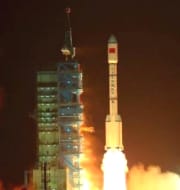China successfully launches its longest ever manned mission to space
China has successfully launched longest-ever manned mission by taking two astronauts Jing Haipeng (50) and Chen Dong (37) into the orbit.
They were launched on board of Shenzhou-11 (heavenly vessel) spacecraft from the Jiuquan Satellite Launch Centre near the Gobi Desert in northwest China. The spacecraft was put into orbit by a Long March-2F carrier rocket.
Key Facts
- Both astronauts will spend a month aboard an experimental space laboratory Tiangong-2 (Heavenly Palace 2).
- During the mission, they will conduct aerospace medical experiments, space science experiments and in-orbit maintenance with human participation.
- They will also undertake ultrasound tests during space travel for the first time, cultivate plants in space etc.
- The Shenzhou-11 mission is China’s sixth manned spacecraft. It will be first time that Chinese astronauts will stay in orbit for medium term.
- Earlier in 2013, three Chinese astronauts in a manned space mission had spent 15 days in orbit and were docked with a space laboratory Tiangong 1.
Comment
Tiangong-2 was launched in September 2016 as part of China’s efforts to set up its own permanent manned space station by 2022. It is China’s second experimental space station module and had upgraded habitat with improved life support systems, power, communications and research equipments. By launching longest-ever manned space mission, China has moved a step closer to establish its permanent space station. After completion, it will make China, only the country to have space station facility is space as the current in-service International Space Station (ISS) retires by 2024.
Month: Current Affairs - October, 2016


